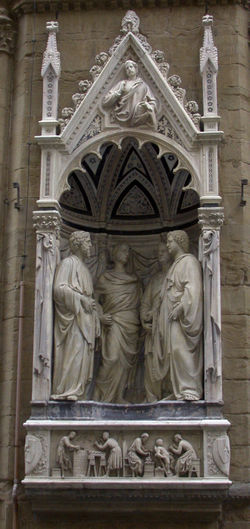Nanni di Banco

This article needs additional citations for verification. (December 2015) |
Nanni di Banco | |
|---|---|
 | |
| Born | c. 1385 |
| Died | 1421 |
| Nationality | Italian |
| Known for | Sculptor |
| Movement | Italian Renaissance |

Nanni d'Antonio di Banco (c. 1384 – 1421) was an Italian Renaissance sculptor from Florence. He was a contemporary of Donatello - both are first recorded as sculptors in the accounts of the Florence Duomo in 1406, presumably as young masters.[1]
Early life[edit]
He was born about 1380 in Florence, Italy, the son of Antonio di Banco, a sculptor who worked at Florence Cathedral, Santa Maria del Fiore.[2] Attempts have been made to determine more precisely the year of his birth, which is generally placed at least between 1375 and 1390, given what is known of the chronology of other artists active in the same period,[3] In particular Donatello, with whom Nanni seems to have had a close professional connections, though Donatello was not, as Vasari thought, Nanni's instructor. As to Nanni's training, this probably took place within the circle of Florentine masons and sculptor at work on the Cathedral, and in particular in the context of the work known to have started in 1391 on the decoration of the north door, later called the Porta della Mandorla. It is known that in February of 1405 Nanni was admitted into the guild known as the "Arte dei Maestri di Pietra e Legname", membership of which gave him the status as a qualified sculptor and allowed him to work aas such at the cathedral. Nanni and his father were commissioned to carve for the Cathedral the statue of the prophet Isaiah.[4]
Career[edit]
Antonio was strictly a stone-carver resulting in the sculpture done by Nanni alone. Nanni was the Magister of his and his father’s workshop where Donatello was recruited from to build the sculpture David. Nanni was selected to carve a sculpture of St. Luke which took him 5 years to complete. He is mostly known for his work in transitioning from gothic to renaissance art.
Colleagues[edit]
A contemporary of Donatello and Lorenzo Ghiberti, Nanni was a sculptor in fifteenth-century Florence.[5] He is well known for his sculpture group Four Crowned Martyrs (Quattro Santi Coronati) (1412–15) which was commissioned by the stone carvers and wood workers guild for the Church of Orsanmichele.[6] The significance of this work is not only the striking naturalism and individuality of the figures, but also the complexity of construction of a sculpture group.
Works[edit]
Nanni di Banco made a name for himself in the transition from International Gothic art to Renaissance art creating a path for Early Renaissance in Florence. Many of his works are displayed inside the Cathedral, the church and museum of Orsanmichele in Florence. His first major work was a statue of the Isaiah in 1408 for the Cathedral his father worked for.
The Quattro Coronati was created in 1416. At this time many artists wanted to depict pagan gods and saints but were hung. Nanni di Banco decided to depict a dialogue between four saints, creating the title. The sculpture not only shows dialogue but also demonstrates the extent to which human behavior can be portrayed by stone. It is easy to find ancient Roman influence on the four sculptures. Many of the faces and togas look similar to ancient Roman republican sculptures. Artists were required to develop a sculpture for the outside of church St. Michele. Nanni’s colleague, Donatello, is credited to sculpt one saint. However, Nanni di Banco portrays a dialogue in which only one of the four men is speaking and the rest are listening, not directly looking at the subject but still engaging in conversation.
San Luca is a marble sculpture, in works with the renaissance artist Donatello. Nanni di Banco exploits the themes of humanism and a new proposal to human expression. Furthermore, we can understand how the influence of this movement was to express the outline and the human face through shadowing and posture.
Giorgio Vasari includes a biography of Nanni di Banco in his Lives of the Most Excellent Painters, Sculptors, and Architects.
Main works[edit]
- Main relief of the Assumption, Porta di Mandorla, Florence Cathedral (1414–21)
- St. Luke (1408-1415), Florence Cathedral
- Quattro Santi Coronati (Four Saints) (1408–15) - Orsanmichele, Florence
References[edit]
- ^ Seymour, 30
- ^ "Nanni di Banco Biography of Early Renaissance Florentine Sculptor & Architect". Encyclopedia of Sculpture.
{{cite web}}: Missing or empty|url=(help) - ^ "Nanni di Banco. Biography of Early Renaissance Florentine Sculptor & Architect". Encyclopedia of Sculpture.
{{cite web}}: Missing or empty|url=(help) - ^ "Nanni di Banco, Italian Sculptor". The Editors of Encyclopaedia Britannica.
{{cite web}}: Missing or empty|url=(help) - ^ Hartt, Frederick (1994). History of Italian Renaissance art: painting, sculpture, architecture (4th ed.). Englewood Cliff, N.J.: Prentice Hall. ISBN 0-13--393380-6.
- ^ Turner, Richard (2005). Renaissance Florence : the invention of a new art. Englewood Cliffs, N.J.: Prentice Hall. ISBN 0-13-134401-3.
